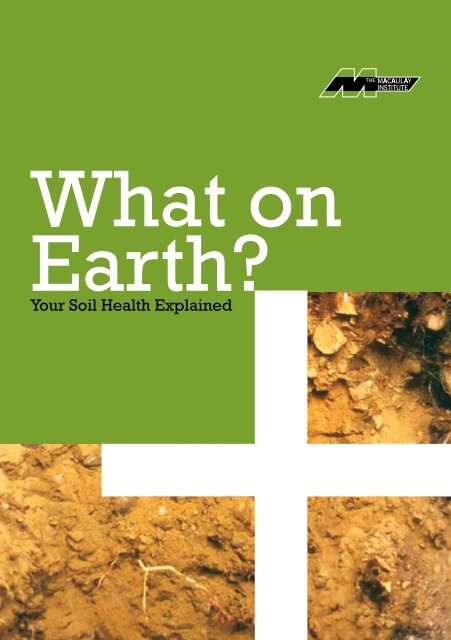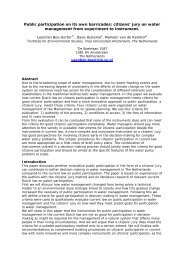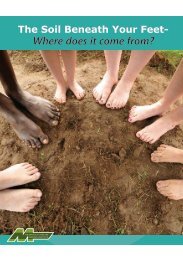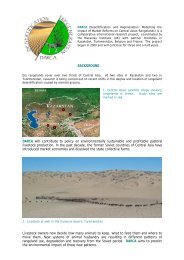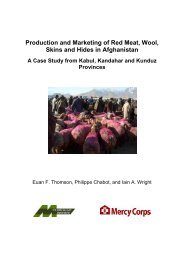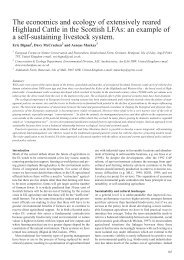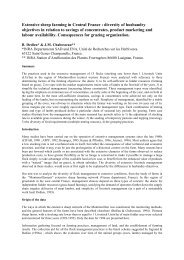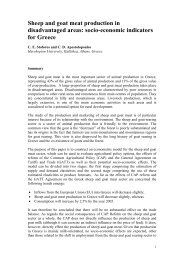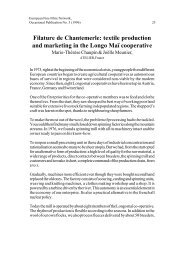Soil booklet - The Macaulay Land Use Research Institute
Soil booklet - The Macaulay Land Use Research Institute
Soil booklet - The Macaulay Land Use Research Institute
- No tags were found...
You also want an ePaper? Increase the reach of your titles
YUMPU automatically turns print PDFs into web optimized ePapers that Google loves.
00What onEarth?Your <strong>Soil</strong> Health Explained
01You could be forgiven for writing-offsoil as just dirt, but if we didn’t have soil wewouldn’t have food to eat, or freshwater todrink.Even the paper on which this is printed camefrom trees that couldn’t have grown without asoil that was fit and well.This leaflet explains the importance of soilto our everyday lives and why a healthy soilmeans a healthy nation.<strong>Soil</strong> can affect what is in our air and water andwe will explain why this is the case.It’s Alive!<strong>Soil</strong> is teeming with life - much of which we cannot see – but like allliving things it can become unwell and even die if it isn’t looked afterproperly.You might be surprised to learn there are more living things in one teaspoon ofsoil than there are people on the planet. One gram of soil can contain severalbillion bacteria from thousands of different species.Many life forms make soil their home, and in turn most other animals dependupon them for food.Life within soil ranges from the microscopic (such as bacteria and other socalledmicroorganisms) through to more recognisable and well known speciessuch as earthworms, and many rare types of ant.<strong>The</strong> roots of plants that grow within it are another important form of life that wefind in soils.And then there are the various large animals that make their homes in it.In fact, the world’s largest living thing – a honey mushroom measuring over3 miles across – has been discovered lurking in the soil beneath a NorthAmerican forest.Every single life form on land depends on a healthy soil to survive. <strong>The</strong> plants,the animals which feed on the plants, and the animals that eat the animalswhich feed on the plants – none of them would exist if it wasn’t for a living soil.
02 03Last gasp?Breathing is a sign of life – and soils are no exception.With all that life in soils it is no surprise that, just like us, soils producecarbon dioxide as a waste product and breathe it out into the air.<strong>The</strong> rate at which they do this is dependent on - amongst other things- moisture and temperature.As our climate changes, so will the amountof carbon dioxide our soils are likely tobreathe out.<strong>Soil</strong>s hold about 30 times the amount ofcarbon dioxide we release annually byburning fossil fuels .If the rate of soil breathing increases,it will greatly contribute tofurther climate change.<strong>The</strong> carbon that soil will losein this way has been in thesoil for a long time - and itwill take a long time toreplace.Muddying the waters<strong>The</strong> human kidney removes harmful toxins whilst regulating thebody’s water content. <strong>Soil</strong>s perform a similar role for theenvironment...<strong>Soil</strong>s filter water, making wastes and pollutants harmless, therebyproviding us with safe, clean water.However, damaged and degraded soils can seriously affect ourwaterways and our water supplies.Some soils are less able to retain pollutants than others. This canincrease the runoff of these pollutants into rivers, which causesproblems as algae increase by feeding on the nutrients washeddownstream.<strong>The</strong>se algal blooms can starve other species - such as fish - of oxygen.<strong>The</strong>y might be colourful but they indicate that the water quality hasbeen reduced.Unhealthy soils also increase the risk of flooding as their ability toabsorb and drain away water is reduced. Such water logging can makefields difficult to cultivate. <strong>The</strong>se soils may have been damaged becausewe have treated them badly by taking heavy machinery onto them, butthey can be repaired quite readily.
04 05Foundation of the nationMany centuries ago, there were no big towns and cities, and the wholecountry was covered in soil. But in some places this has been replacedby houses and factories, and more recently by things like motorwaysand airports.Each year in Scotland an area of soil the size of Dunfermline is lostforever – because we put new houses, supermarkets and other buildingdevelopments on top of it. This is the equivalent to an increase of 50 000people, yet our population is not growing at this rate. Are we using moresoil than we really need to?Much of the land being lost is good quality farm land. If we continueto build on it like this we might not have the land to produce enoughto eat– meaning we would have to import even more of our food fromabroad.So we need to be more careful about where and how many newdevelopments we should have in Scotland. Not just for the health of thesoil, but also for the health of its people.Can’t stand losing youThird degree burns or a severe cut can permanently remove the skinfrom the body- when this happens to the soil (the skin of the planet)we call it soil erosion.In some parts of the world it is the start of the formation of deserts.If soil is left without the protection of covering vegetation it becomesvulnerable to the scouring action of wind and rain.Some soils become degraded because water washes it away. Whenit is washed into waterways it causes more sedimentation and siltingdownstream, contributing to problems with water quality, and when it isvery serious it can get into the gills of fish and kill them.Some soil erosion can be prevented if we manage our soils morecarefully, in the same way that some human illnesses are preventable ifwe take care of our health.Each year in Scotlandan area of soil the sizeof Dunfermline is lostforever
10 waysto improve your soil health1 Always remember soil is a living thing - it needs to breathe andfeed - so add organic matter and avoid flooding with water. If youcan get some, add organic fertiliser (but try not to use peat).2 Don’t try and work your soil when it is too wet - it can damage thestructure.3 Do not compact soil too much and avoid overuse of heavymachinery.4. Compost and re-cycle garden waste.5 Always only add the correct amount of fertiliser, weedkiller andfollow instructions of when and where to apply.6 Don’t remove all the stones in soil, they are good for drainage.7 Match your plants to your soil and try to plant as much as possibleleaving the minimum of bare ground - this protects the soil fromwind and rain erosion.8 If you are moving plants or digging foundations try to retain the soiland re-use elsewhere.9 Try and leave soil surfaces free to breathe rather than cover withconcrete or tarmac. <strong>Use</strong> web matting instead of solid covering if youneed hard standing areas - it can continue to filter and breathe.10 Plant across slopes in rows or use terraces or walls to retain rainwashed soil so it is not lost.<strong>The</strong> <strong>Macaulay</strong> <strong>Institute</strong>CraigiebucklerAberdeenAB15 8QHT: +44(0)1224 498200E: enquiries@macaulay.ac.ukwww.macaulay.ac.uk


